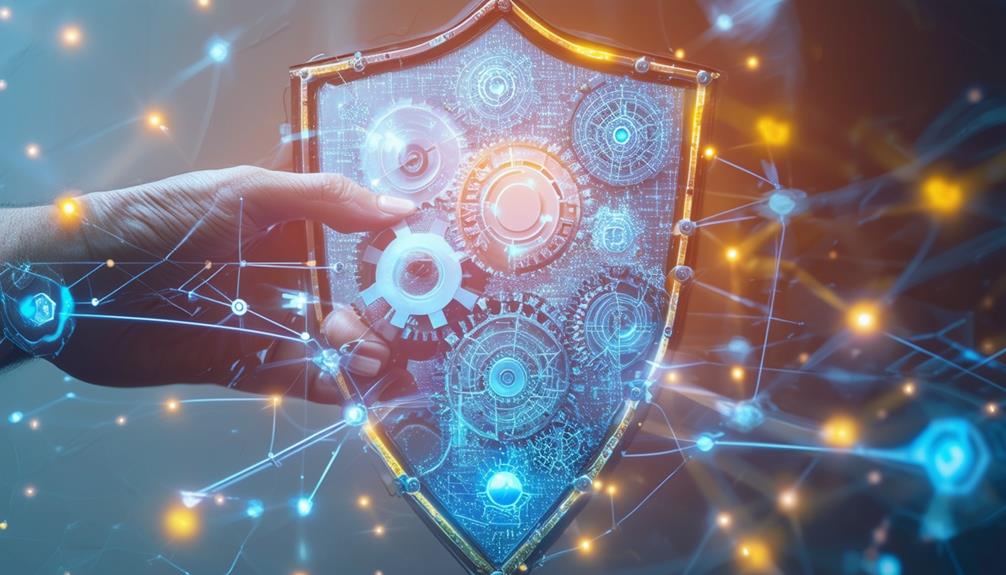The evolution of machine learning in cybersecurity is a transformative journey. From Alan Turing's pioneering work on the theoretical foundations of computer science to the development of expert systems, machine learning, and deep learning, we have leveraged these advancements to enhance threat detection and response. With the integration of AI and human capabilities, we have shifted from reactive to proactive defense strategies. Turing's ideas on algorithmic logic greatly contributed to machine learning, which now powers AI-driven cybersecurity solutions. Mainframe computers marked the birth of cybersecurity protocols, and AI integration has revolutionized threat detection capabilities. What's next in this ever-evolving landscape?
Key Takeaways
- Early applications of machine learning in cybersecurity date back to the 1960s and 1970s with mainframe computers enabling robust data processing.
- Alan Turing's theoretical foundations, such as the Turing Machine, influenced the development of machine learning in cybersecurity.
- Supervised machine learning is used to classify data, predict outcomes, and enhance threat detection, with features such as decision tree algorithms and dimensionality reduction.
- Advances in deep learning led to anomaly detection systems and proactive threat hunting techniques.
- The integration of AI-driven cybersecurity solutions with human expertise enhances defense strategies and promotes adaptability against cyber threats.
Turing, Machines, and Theoretical Foundations
Alan Turing's groundbreaking work on theoretical computer science, such as the Turing Machine, laid the foundation for machine learning principles by demonstrating how algorithms can drive computational processes.
The Turing Machine, a theoretical model of a simple computing device, showcased that all computation can be performed by a machine following a set of rules. This concept, known as the Church-Turing thesis, revolutionized the understanding of computability and had a profound influence on the design of early computing systems.
Turing's ideas on algorithmic logic have contributed significantly to the development of machine learning, allowing computers to learn from data and adapt to new situations. These theoretical foundations continue to shape the design and implementation of machine learning algorithms in cybersecurity. They've played a crucial role in fortifying digital landscapes against evolving threats.
As we explore the intersection of AI and cybersecurity, it's essential to recognize the significant impact of Turing's work on the evolution of machine learning principles.
Early Days of Computing
The advent of mainframe computers in the 1960s and 1970s, built upon the theoretical foundations laid by pioneers like Alan Turing, marked a transformative milestone in the development of early computing infrastructure. These powerful machines were the precursor to the server architectures we see today, allowing for large-scale data processing and laying the groundwork for the development of computer security as it's comprehended today.
Data Processing: Mainframes enabled robust data processing capabilities, a critical element for machine learning in cybersecurity.
Learning from Early Viruses: The emergence of the first computer viruses highlighted the need for cybersecurity protocols and defense mechanisms.
Algorithmic Logic: Lessons from early computing, such as algorithm logic, directly influenced security strategies in the digital era.
Theory Meets Practice: The historical significance of the Turing Machine in shaping algorithmic thinking for cybersecurity applications can't be overstated.
Potential for AI: The potential of AI and ML in detecting and preventing modern threats grew from these early computing advancements.
These early developments may seem ancient by today's standards, but their influence on cybersecurity and machine learning is undeniable.
The Birth of Cybersecurity

When I look back at the early days of computing, I realize that Alan Turing's groundbreaking work in AI laid the foundation for modern cybersecurity principles. Turing's contributions were instrumental in shaping the way we protect digital assets today.
As mainframes emerged, the need for securing these powerful systems against malicious attacks became increasingly clear, marking the birth of cybersecurity.
Alan Turing: Father of AI
If we further explore into the history of artificial intelligence and cybersecurity, we find that the groundwork laid by Alan Turing has profoundly shaped the most advanced security protocols today. Turing's concept of the Turing Machine established the algorithmic logic that modern computers and cybersecurity systems rely on.
His contributions to cryptography and code-breaking during World War II greatly impacted the development of cybersecurity protocols, making him a critical figure in the birth of modern cybersecurity.
- Groundbreaking Theoretical Work: Turing formalized the concepts of algorithms and computation through his Turing Machine.
- War-Time Contributions: His code-breaking and cryptography efforts supported the Allies in World War II.
- Machine Intelligence Pioneer: Turing introduced the concept of machine intelligence, influencing problem-solving and decision-making.
- Impact on Cybersecurity: His principles and theories continue to shape the evolution of machine learning in cybersecurity.
- Legacy in AI: Turing is widely regarded as the Father of AI for his pivotal work in theoretical computer science and artificial intelligence.
Early Computing Era
As computer technology took its first significant strides, I witnessed the emergence of mainframe computers in the 1960s and 1970s, which marked the birth of cybersecurity protocols. These early computing systems, expensive and primarily used for scientific and military purposes, initially focused on developing and refining their capabilities rather than addressing security concerns. Hence, security measures centered around physical access to the hardware and user authentication via password systems. The seeds of cybersecurity were sown during this era, but it took the arrival of computer viruses to raise the stakes.
In the 1960s, IBM conducted a usability experiment, inviting students to interact with their new computer system. This led to the discovery of potential vulnerabilities and an early foray into ethical hacking.
Emergence of Mainframes
Cybersecurity measures were initially centered on physical access control and password systems as mainframe computers began to dominate the computing landscape in the 1960s and 1970s. These early cybersecurity efforts signaled the significant shift toward protecting sensitive data from unauthorized access and emerging cyber threats. As mainframes became more prevalent, the need for robust security protocols grew.
This led to the development of specialized operating systems, early incident response strategies, and foundational principles for digital defense.
- Mainframes introduced a new level of sophistication in data storage and computational power.
- Physical access control and password systems were the primary means of securing mainframe systems.
- Early cybersecurity measures were implemented to safeguard mainframe data against unauthorized intrusions.
- Incident response strategies began to take shape in response to early cyberattacks.
- The evolution of mainframes set the stage for more advanced cybersecurity protocols and strategies.
The emergence of mainframes played a pivotal role in shaping the future of cybersecurity, as they highlighted the critical need for robust digital defense and information security practices to protect sensitive data.
Expert Systems
As I explore further into the evolution of cybersecurity, I turn my focus to expert systems—AI systems designed to replicate human decision-making processes.
Developed in the 1970s, these systems relied heavily on extensive knowledge bases and inference engines to process and apply data. While they were groundbreaking at the time, their limitations in adaptability eventually gave way to the emergence of machine learning algorithms.
AI: Simulating Human Decision-Making
Machine learning's ability to simulate human decision-making processes through expert systems marks a pivotal milestone in the advancement of AI-driven cybersecurity solutions. By harnessing the capabilities of expert systems, cybersecurity infrastructures can now leverage the power of artificial intelligence to tackle increasingly complex threats.
Expert systems, designed to emulate human decision-making, consist of two pivotal components: knowledge bases and inference engines. Knowledge bases store the accumulated expertise garnered from human experts, while inference engines apply these rules to generate informed decisions. The robust integration of these components enables AI-driven cybersecurity solutions to mimic the thoughtful deductions of human experts, enhancing threat detection and security applications.
- Key Features of Expert Systems:
- Knowledge Bases: Store human expert knowledge for informed decision-making.
- Inference Engines: Apply rules from the knowledge base to make decisions.
- AI Integration: Enhances threat detection and security applications.
- Emulation of Human Expertise: Simulates human decision-making processes.
- Limitations: Not replacing human judgment, but augmenting it to improve efficiency.
Logic and Inference Engines
Building on AI's ability to simulate human decision-making processes, cybersecurity exploits expert systems empowered by logic and inference engines to combat sophisticated threats. Early calls for AI technologies in enforcement for enhanced threat recognition and response.
Expert systems relied on advanced knowledge bases and powerful inference engines to analyze and apply logical rules to recognize and deflect dangers. To date, these systems still play a pivotal role in birth cybersecurity tactics for identifying and countering threats; this includes the ability to diagnose attacks and predict response measures in real-time.
Needed, the knowledge base, which houses domain-specific details, interacts with the inference engine to draw conclusions and propose decisions. Additionally, this integration enables cybersecurity authorities to analyze an immense amount of information from various sources to enhance the effectiveness of their defense strategies.
However, limitations about these early expert systems led to the rise of more complex machine learning algorithms. This shift opened doors to automation, enabling AI capabilities to enhance cybersecurity mechanisms and protect digital environments.
Machine Learning Evolution

The history and development of machine learning in cybersecurity have undergone significant changes over the decades. Spanning from rule-based systems in the late 1980s to the revolutionary impact of deep learning in the 2010s, these transformations have reshaped the threat detection landscape.
This evolution was primarily fueled by the surge of Big Data post-2000, which led to notable advancements in AI and ML algorithms specifically tailored for threat detection.
- Advances in Supervised Machine Learning: The late 2000s witnessed the rise of supervised machine learning, significantly enhancing threat detection accuracy.
- Deep Learning Revolution: The 2010s marked a substantial change with the deep learning revolution in cybersecurity. Neural networks proved to be highly effective in learning complex patterns.
- Anomaly Detection Evolves: Anomaly detection systems, which were initially rule-based, evolved into more sophisticated machine learning and deep learning models. This advancement significantly boosted their effectiveness.
- Adaptive Threat Response Enabled: Machine learning algorithms played a crucial role in enabling real-time adaptive threat response mechanisms. These algorithms paved the way for automated mitigation systems.
- Cybersecurity Evolution: The continuous improvement in AI models has been instrumental in driving a profound evolution in cybersecurity practices. This shift has moved the focus from reactive to proactive threat hunting techniques.
Deep Learning and Neural Networks
Deep learning's adoption in cybersecurity has imbued our systems with the remarkable ability to mimic human brain processes, orchestrating sophisticated neural networks that excel at automated feature extraction and pattern recognition. These networks are particularly effective in tackling complex tasks, such as threat intelligence gathering, like large language models such as ChatGPT. This breakthrough has been instrumental in enhancing our AI-driven cybersecurity solutions.
One of the key advantages of deep learning models is their capacity to adapt and learn from large amounts of data, enhancing their performance over time. This enables them to detect and respond to emerging threats in a more rapid and efficient manner.
However, deep learning models also face unique challenges, particularly in the context of adversarial attacks. These attacks intentionally aim to mislead models by injecting malicious data, which can lead to inaccurate predictions and compromises. Therefore, ongoing research focuses on developing robust countermeasures to mitigate these adversarial attacks and maintain the continued reliability of deep learning models in cybersecurity.
Recent Developments in Large Language Models

ChatGPT's remarkable impact on cybersecurity is evident in its unparalleled processing of vast text volumes to generate human-like responses that amplify threat intelligence capabilities. Its transformative potential cuts across multiple facets of cybersecurity, from threat detection to response.
- Transformer Architecture: Large language models like ChatGPT harness the transformer architecture to understand and generate human-like text responses, elevating natural language processing capabilities.
- Enhanced Contextual Understanding: By leveraging these models, cybersecurity tasks benefit from enhanced contextual understanding, leading to more effective threat detection and response.
- AI-driven Cybersecurity: Recent advancements in large language models have bolstered AI-driven cybersecurity strategies, providing enhanced tools for cybersecurity professionals.
- Human-like Responses: These models demonstrate an uncanny ability to generate human-like text, enhancing threat intelligence by processing vast amounts of text data.
- Future of Cybersecurity: As AI technology continues to advance, we can expect large language models to play a pivotal role in shaping the future of cybersecurity strategies and operations.
The Emergence of Quantum Computing
As quantum computing gains traction, its extraordinary processing capabilities are necessitating a fundamental shift in cybersecurity strategies to protect sensitive data from potential quantum threats.
Quantum computers utilize quantum-mechanical phenomena like superposition and entanglement for data processing, allowing them to solve complex computational problems exponentially faster than classical computers. This new landscape has significant implications for artificial intelligence and machine learning in cybersecurity.
Importantly, quantum algorithms like Shor's algorithm threaten current encryption methods, making quantum-resistant cryptography an imperative for securing sensitive information.
In response, innovative strategies are emerging to protect sensitive data. For instance, researchers are proposing solutions that integrate classical encryption methods with quantum-resistant protocols. Additionally, advancements in quantum error correction codes, such as surface code, are helping to improve the reliability of quantum technologies.
As quantum computing continues to mature, it's essential for cybersecurity professionals to adapt and develop robust strategies to safeguard against quantum threats.
Combining AI and Human Capabilities

Harnessing the combined strength of human expertise and AI analytical capabilities is vital for thorough threat detection and defense in the cybersecurity landscape. The integration of AI-driven systems with human analysis adds a layered approach to cybersecurity, whereby both domains can leverage their respective strengths to maximize security.
- *AI models can analyze vast datasets quickly, identifying patterns and anomalies, while human oversight ensures ethical governance and accountability. Transparent AI algorithms promote trust and enhance collaboration, allowing cybersecurity professionals to make informed decisions.*
Efficient threat detection relies on the harmonious collaboration between human intelligence and AI capabilities.
Human oversight is essential for ensuring ethical governance and preventing potential AI-driven cybersecurity breaches.
Clear accountability frameworks for AI outcomes are necessary to maintain trust in AI-driven defense systems.
The future of cybersecurity will increasingly depend on a collaborative approach, blending machine learning with human expertise to create robust defense strategies.
Frequently Asked Questions
When Was Machine Learning Used for Cybersecurity?
"I first used machine learning for cybersecurity in the late 1980s for anomaly detection, implementing rule-based systems for threat prevention via real-time monitoring and predictive modeling."
How Is Machine Learning Used in Cybersecurity?
"As a cybersecurity expert, I leverage machine learning for advanced threat detection through anomaly detection, behavioral analysis, and malware detection. It enhances network security, identifies insider threats, secures user authentication, encrypts data, and optimizes vulnerability assessment and incident response."
When Was AI First Used in Cybersecurity?
AI first entered cybersecurity in the mid to late 1980s, initially for anomaly detection. Early applications foreshadowed significant advancements in proactive cyber defense mechanisms to identify and respond to emerging threats.
How Is AI ML Transforming Cybersecurity?
I'm witnessing a cybersecurity revolution where AI and ML integrate to proactively detect anomalies, monitor network activities, and respond to threats via predictive modeling, leading to enhanced security analytics and more effective fraud detection.










1 comment
Comments are closed.